What is implicit learning?
Implicit learning is learning that occurs without awareness that it is happening. It simply means that a person can acquire knowledge without the explicit intent or realization of doing so. Implicit learning describes learning that happens through external experience, day-to-day interaction, and general practices. Instead of focusing on rote memorization and the rules themselves, implicit learning is the effect of using knowledge to solve problems, learn from mistakes, and develop natural instincts for new patterns or information.
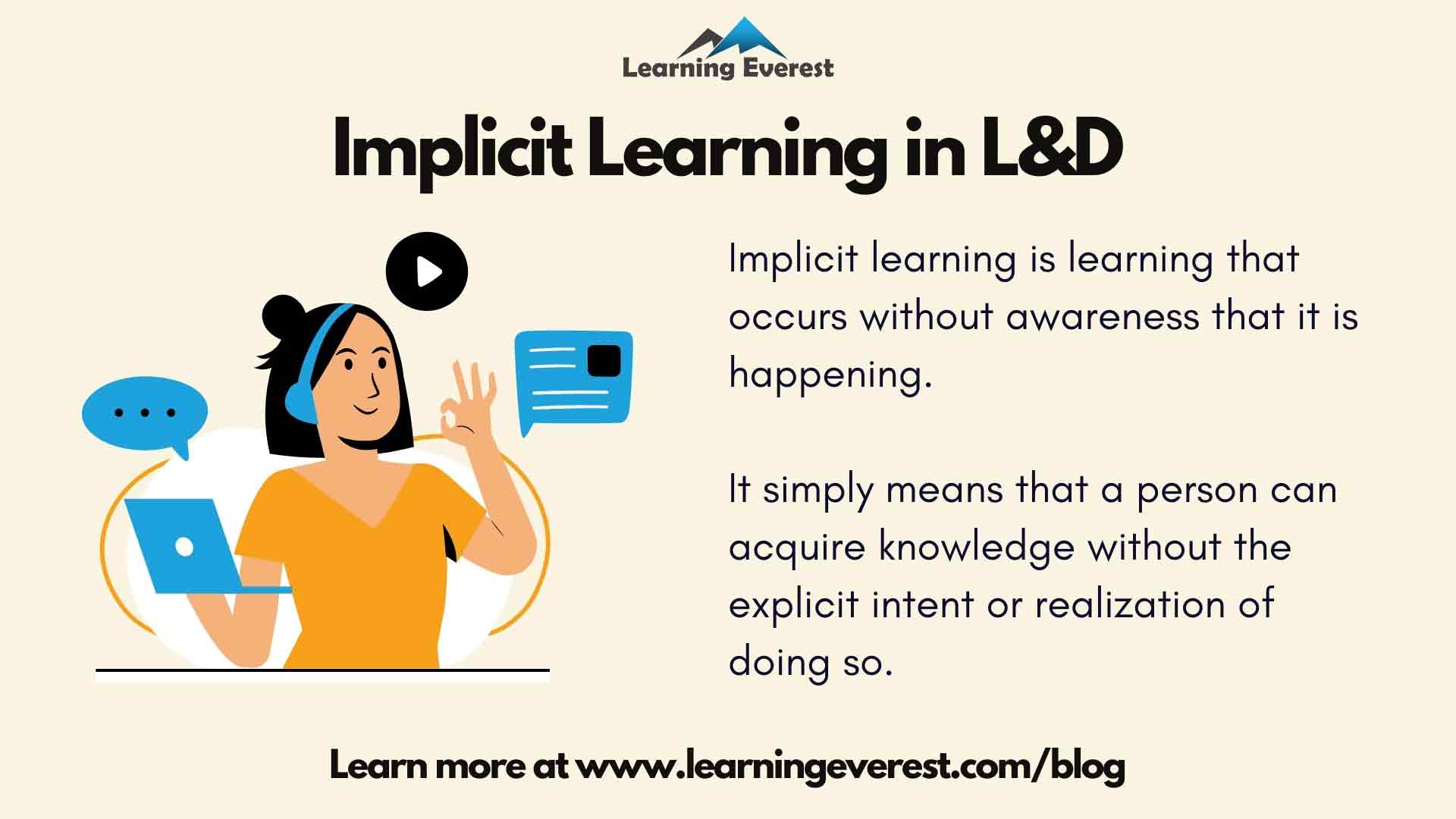

Implicit learning in Learning And Development
Implicit learning is contrasted with explicit learning. Explicit learning refers to learning that happens through direct instruction that tells the learner the knowledge of how something works, or what the pattern is. Let’s see!
What is the difference between explicit and implicit learning?
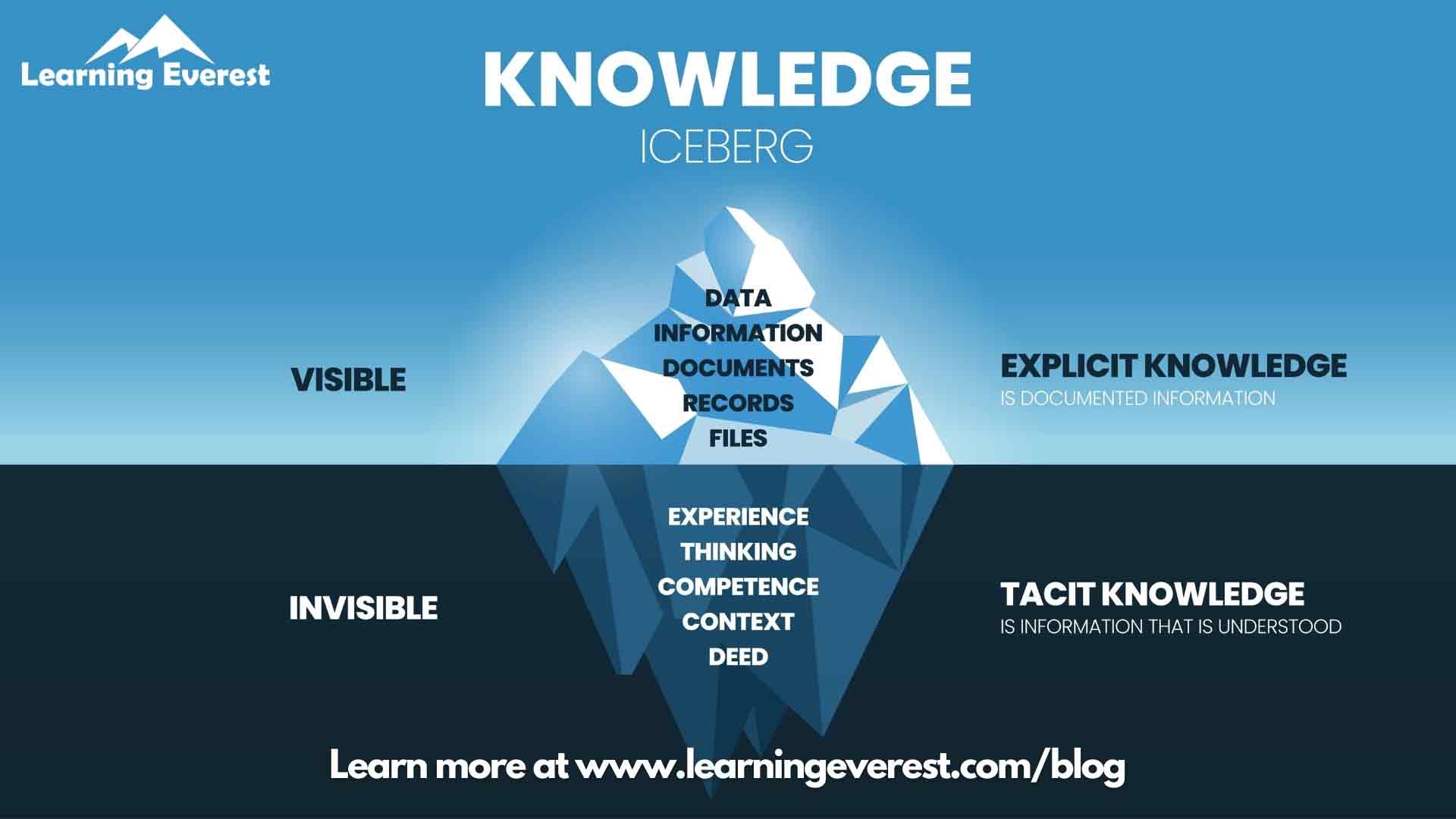

Implicit learning example
| Explicit learning | Implicit learning |
|---|---|
| Explicit learning is equivalent to intentional learning of information | Implicit learning is typically done in the absence of conscious awareness |
| It involves active study and practice | Implicit knowledge is typically acquired over many different episodes |
| For example, memorizing a list of word pairs would be an example of explicit learning | Learning to ride a bike or acquiring a native language as a child |
| Can be easily measured through tests and quizzes | Difficult to measure directly |
Implicit learning examples
A few examples of implicit learning can be:
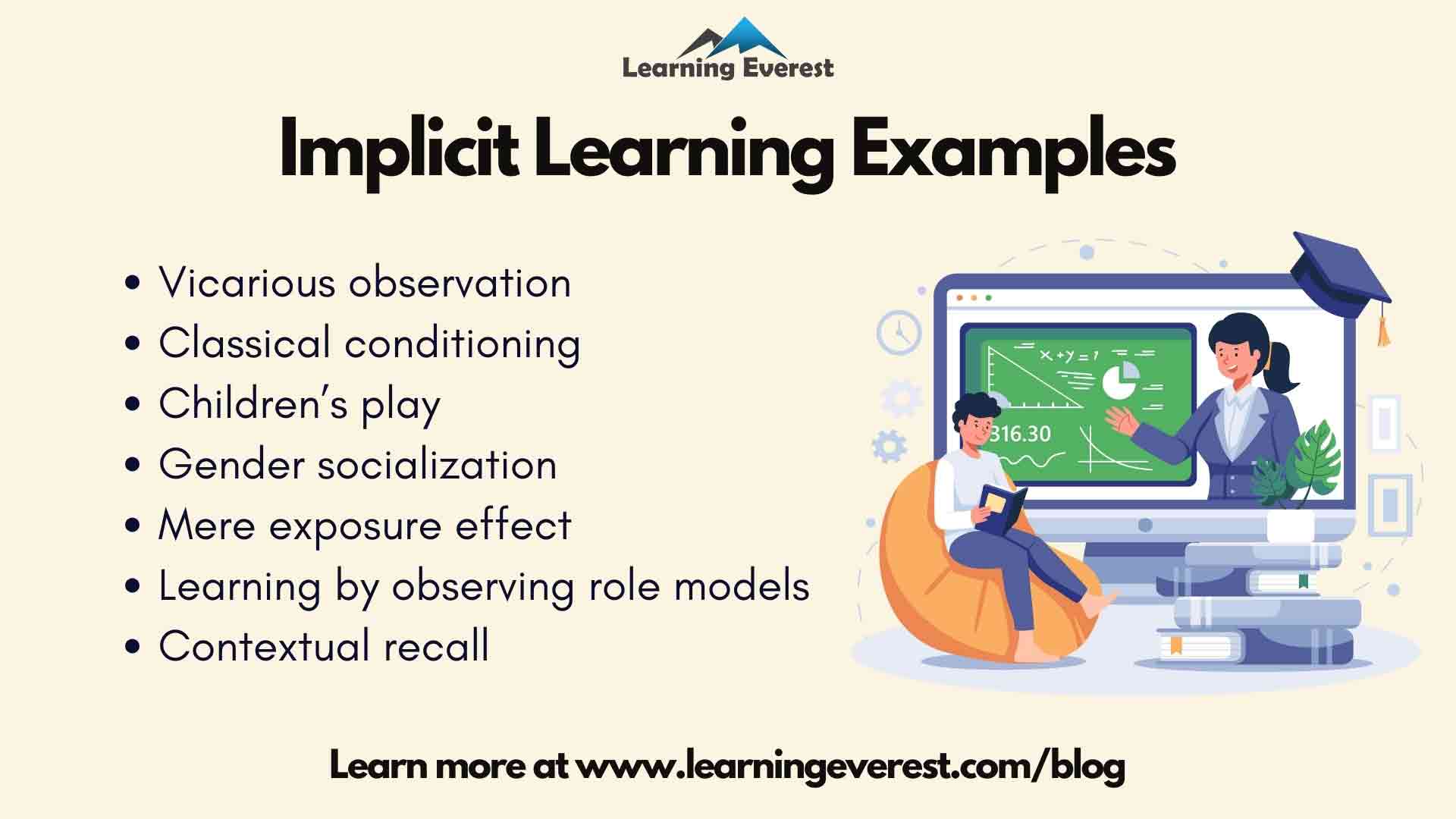

Implicit learning examples
Let’s discuss.
Implicit learning example no. 1 – Vicarious observation
Vicarious learning can sometimes be implicit. For example, a person may observe their siblings being punished for speaking loudly in a restaurant. They subsequently don’t speak loudly. When asked why they’re softly spoken, they can’t explain, but at some point, they learned to speak quietly through vicarious reinforcement that occurred when they observed their siblings being punished for their loud mouths.
Implicit learning example no. 2 – Classical conditioning
Ivan Pavlov’s classical conditioning theory is a typical example of implicit learning. Pavlov trained a dog to associate a bell with the smell of food through repeated pairing of the bell and food. The dog wasn’t given rewards, punishments, or motivations and likely didn’t have a clear moment of realization; rather, it learned slowly and implicitly.
Implicit learning example no. 3 – Children’s play
Kids don’t know they are learning while playing, but they nevertheless learn a lot about hand-eye coordination, social skills, the physical world, and so on.
Implicit learning example no. 4 – Gender socialization
While we might not be explicitly taught how to be masculine or feminine, we nonetheless develop this knowledge of how to conform to our gender norms through socialization with our parents, family, peers, and even through watching television.
Implicit learning example no. 5 – Mere exposure effect
The mere exposure effect explains that people come to like and enjoy things they are exposed to, and dislike things they are not exposed to. Here, we learn to like things not through explicit instruction but through ‘mere exposure’, and often, there is no clear lightbulb moment of learning.
Implicit learning example no. 6 – Learning by observing role models
According to Albert Bandura, learning can happen by watching others and redoing what they do or say. This is called observational learning. There are specific stages in the process of re-modeling that should be followed if learning is to be successful. These stages include attention, retention, reproduction, and motivation.
Implicit learning example no. 7 – Contextual recall
Context can have a powerful impact on our memories. Though other factors influence our recall of information, contextual learning can be used to help us recall and remember. The goal here is to match the context in which knowledge will be recalled to the context in which it is learned. Such as,
- Learning bad habits
- Learning from entertainment
- Learning when traveling
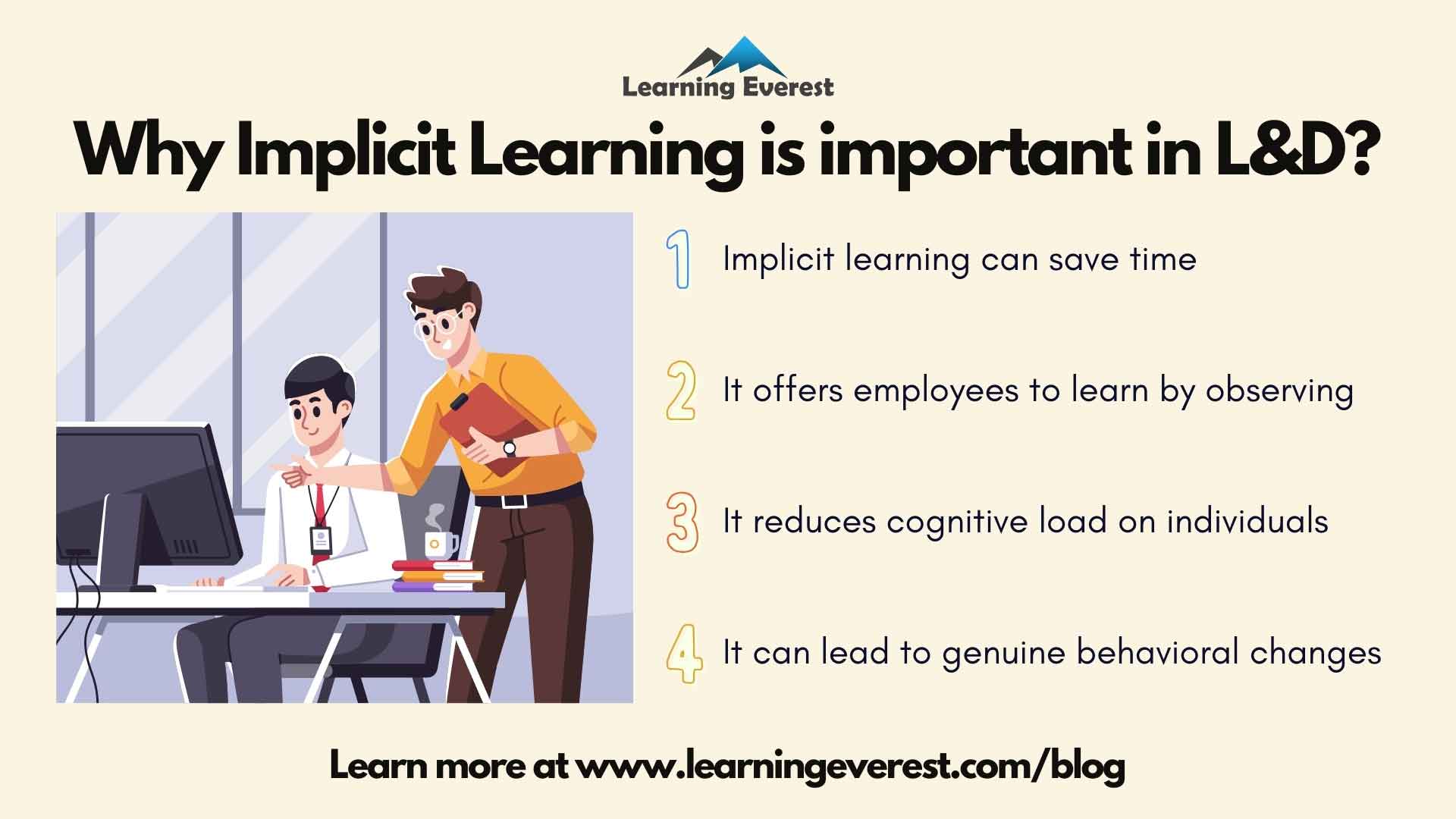

Why Implicit learning is important in Learning and Development
Implicit learning example in L&D
There are a few training methods in L&D that can actually facilitate acquisition without significant conscious efforts. Let’s take a look:
1 – Integration of social learning theory
Social learning theory agrees with implicit learning theory, which is about outside influences on behavior. Scenario-based learning can be used to give compliance training, soft skills training, professional skills training, leadership training, etc. A scenario-based learning environment is exceptional for keeping the learners engaged throughout their learning journey. However, the social learning theory goes further and suggests that internal psychological processes influence behavior.
Implicit learning theory might be applied through role-playing exercises where participants practice negotiation skills. They receive immediate feedback from peers and trainers, which serves as external reinforcement to modify behavior. The program could include a mentorship component where less experienced leaders observe and interact with seasoned executives. This allows them to witness successful behaviors in real-world contexts and understand the internal thought processes behind these actions through discussions and Q&A sessions.
2 – Positive reinforcement
Positive reinforcement is key in implicit learning theory. Without it, learners will quickly abandon their responses because they don’t appear to be working. Going back over the learning material and giving positive reinforcement will help learners retain information much better. The L&D program can use positive reinforcement to encourage continued engagement and improvement; for example, trainers can provide immediate feedback and praise to participants who demonstrate improvement or mastery of their skills.
Moreover, the organization can introduce a leaderboard that tracks progress, and top performers receive recognition during company meetings. Participants who excel in the training program are given opportunities for real-world application. By incorporating these strategies, the training program teaches the desired behaviors and motivates adult learners to continue applying what they have learned.
3 – Gamification
In implicit learning, gamification can be used as a dynamic tool, latching on to learners’ innate desire for challenge and reward. By integrating game-like elements, instructors can encourage engagement and foster creative collaboration. For example, leaderboards or achievement badges can motivate learners to delve deeper into topics, while collaborative games can strengthen networking and peer-to-peer learning. Instructors must strike a balance that ensures that learning is not overshadowed by game mechanics.
To learn more about gamification, read our blog on 5 Game Mechanics to Use in eLearning with Gamification Examples.
4 – Simulations
Computer simulations can offer an immersive learning environment, allowing learners to experiment, make decisions, and observe outcomes in a controlled setting. These simulations can help learners think about difficult concepts and abstract ideas in a safe and cost-effective manner. An example would be that of a simulation of safety training which lets learners interact with danger workplace situations virtually. The goal of this type of learning is to identify a solution or an answer to a real-world problem. It creates real experiences.
To learn more read our blog on How can you integrate scenario-based learning into your customer service training modules?
5 – Mentorship programs
Workplace mentorship programs support implicit learning by bringing together employees at different stages in their careers to swap internal knowledge and discuss case studies. This can inspire others to perform better work or develop particular skills. Mentors can showcase success stories within your organization to inspire your employees and demonstrate how others have successfully navigated similar development paths before. They inspire healthy competition in the workplace. Those who work with them notice how well they perform, and it may inspire them to produce work on the same level or above their level. This atmosphere motivates everyone to place extra effort into their work and achieve new goals.
6 – Repetition is the key
Repetition and positive reinforcement go hand in hand with the implicit learning theory. Educators often work to strike the right balance between repeating the situation and having positive reinforcement come to show learners why they should continue that behavior. This can be in the form of verbal reinforcement and praise, reward systems, added privileges, and more. The training might include several repetitive elements to reinforce learning, such as role-playing scenarios where participants repeatedly practice desired behaviors, weekly workshops to review key negotiation tactics, e-learning modules that participants can revisit to reinforce their knowledge, etc.
To motivate participants, the program could also offer digital badges for each module completed. Additionally, those who complete all modules with high scores might receive a certificate of excellence. This type of recognition serves as positive reinforcement, encouraging learners to continue engaging with the program and strive for high performance.
What else would you like to add?
Infographic
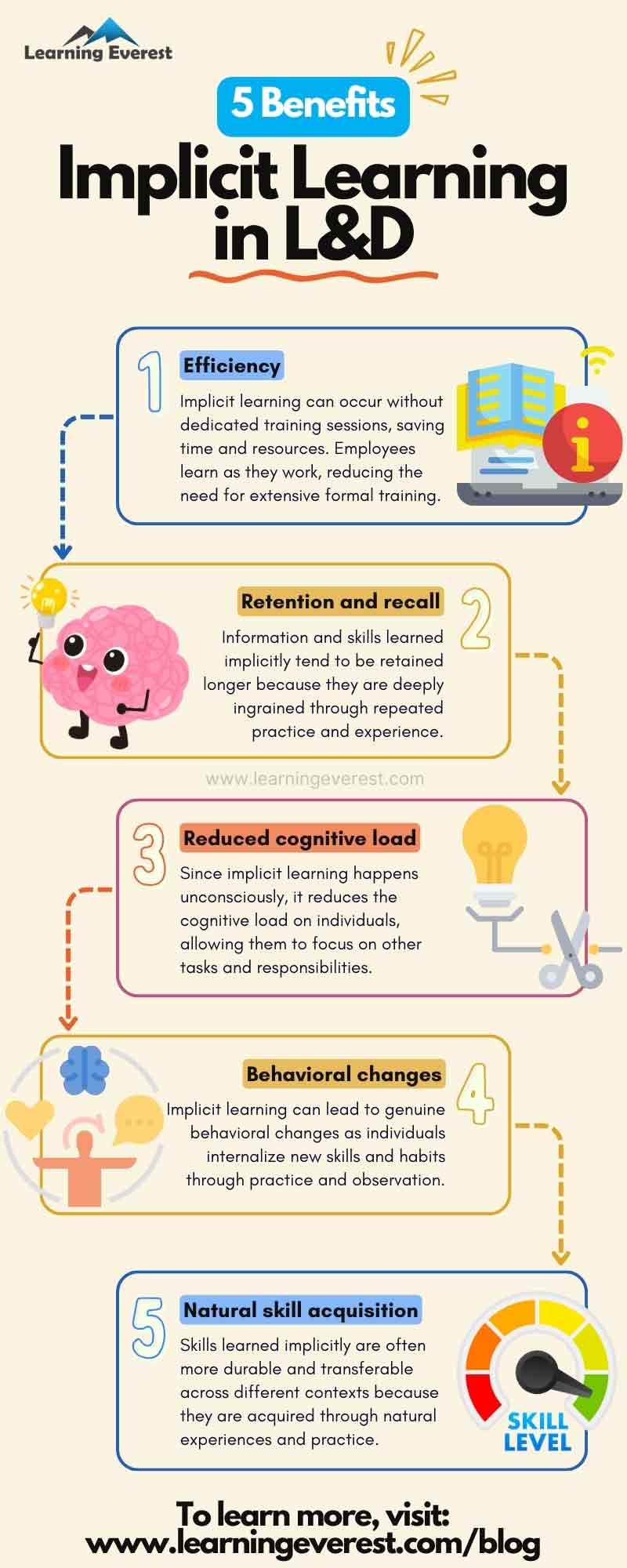

5 Benefits of Implicit Learning in Learning and Development
Knowledge Check!
Frequently Asked Questions (FAQs)
Q: What is implicit learning?
A: Implicit learning is learning that occurs without awareness that it is happening. It simply means that a person can acquire knowledge without the explicit intent or realization of doing so.
Q: What is the difference between explicit and implicit learning?
A: Explicit learning is equivalent to intentional learning of information. While implicit learning is typically done in the absence of conscious awareness.
Q: What is an implicit learning example?
A: Classical conditioning – Ivan Pavlov’s classical conditioning theory is a typical example of implicit learning.